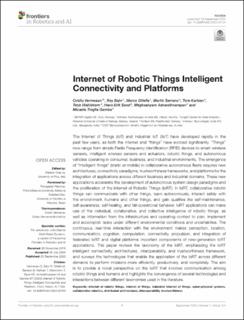| dc.description.abstract | The Internet of Things (IoT) and Industrial IoT (IIoT) have developed rapidly in the past few years, as both the Internet and “things” have evolved significantly. “Things” now range from simple Radio Frequency Identification (RFID) devices to smart wireless sensors, intelligent wireless sensors and actuators, robotic things, and autonomous vehicles operating in consumer, business, and industrial environments. The emergence of “intelligent things” (static or mobile) in collaborative autonomous fleets requires new architectures, connectivity paradigms, trustworthiness frameworks, and platforms for the integration of applications across different business and industrial domains. These new applications accelerate the development of autonomous system design paradigms and the proliferation of the Internet of Robotic Things (IoRT). In IoRT, collaborative robotic things can communicate with other things, learn autonomously, interact safely with the environment, humans and other things, and gain qualities like self-maintenance, self-awareness, self-healing, and fail-operational behavior. IoRT applications can make use of the individual, collaborative, and collective intelligence of robotic things, as well as information from the infrastructure and operating context to plan, implement and accomplish tasks under different environmental conditions and uncertainties. The continuous, real-time interaction with the environment makes perception, location, communication, cognition, computation, connectivity, propulsion, and integration of federated IoRT and digital platforms important components of new-generation IoRT applications. This paper reviews the taxonomy of the IoRT, emphasizing the IoRT intelligent connectivity, architectures, interoperability, and trustworthiness framework, and surveys the technologies that enable the application of the IoRT across different domains to perform missions more efficiently, productively, and completely. The aim is to provide a novel perspective on the IoRT that involves communication among robotic things and humans and highlights the convergence of several technologies and interactions between different taxonomies used in the literature. | en_US |

